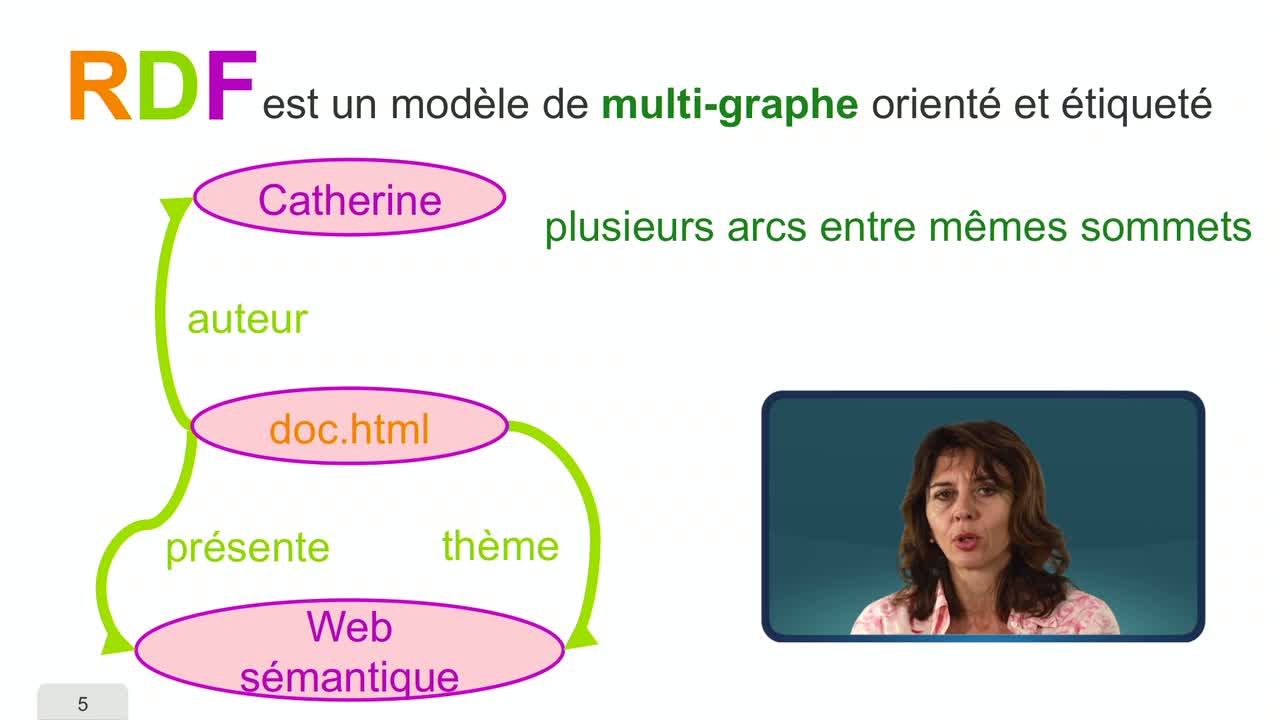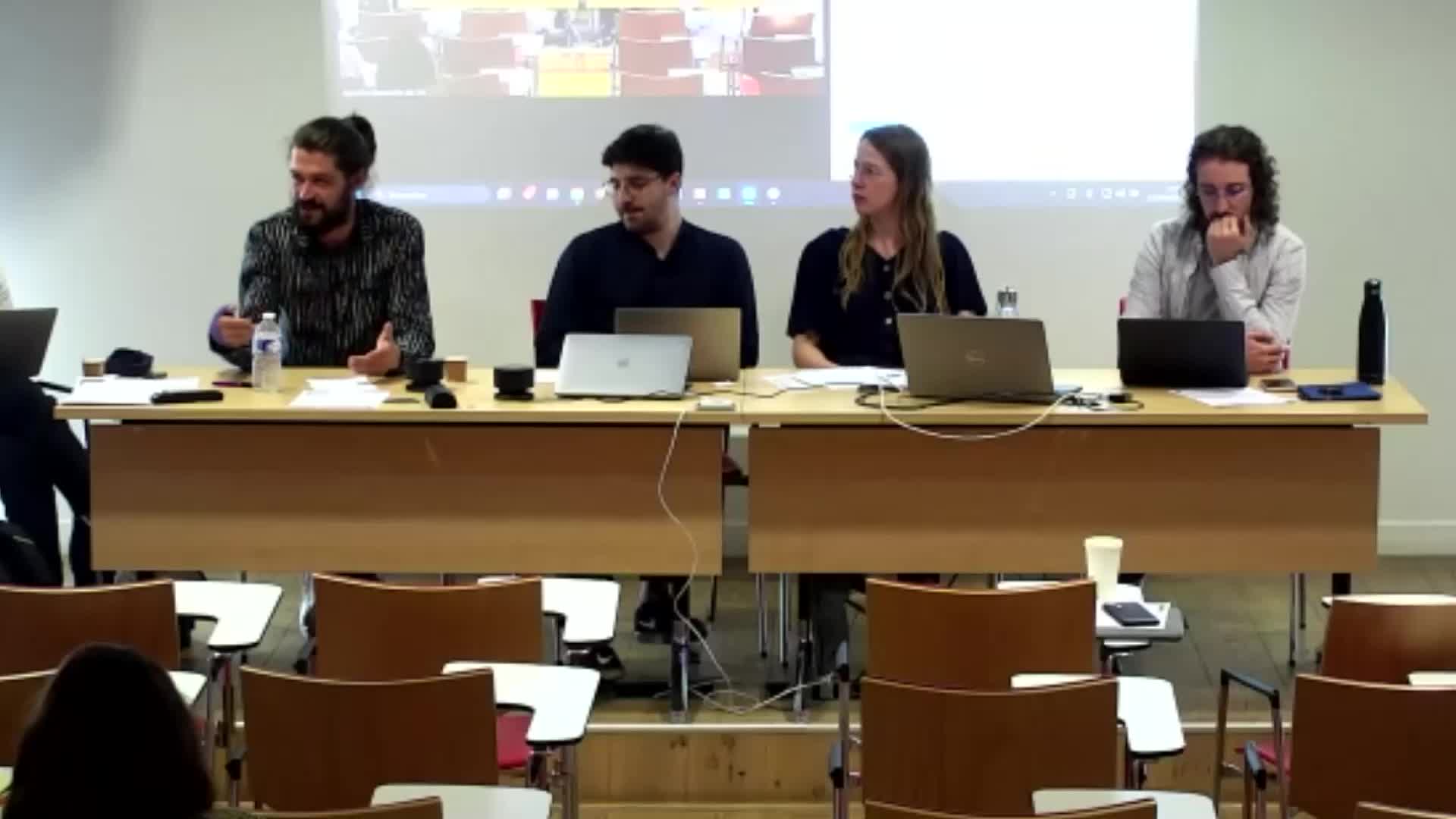Notice
Modèle de triplets et de graphes (1)
- document 1 document 2 document 3
- niveau 1 niveau 2 niveau 3
Descriptif
Cette séquence présente les principes du modèle RDF. Il s'agit d'un modèle de triplets et d'un modèle de graphe.
Intervention / Responsable scientifique
Thème
Documentation
Documents pédagogiques
Pointeurs et références
Dans la même collection
-
Nommer des graphes
GandonFabienFaronCatherineCorbyOlivierDans cette séquence, nous allons voir comment nommer des graphes RDF dans le modèle RDF et quelle en est l'utilité.
-
Syntaxes de sérialisation
GandonFabienFaronCatherineCorbyOlivierNous avons vu dans la séquence précédente les principes du modèle RDF en utilisant une syntaxe abstraite du langage. Dans cette séquence, nous allons voir les différentes syntaxes concrètes qui
-
Groupes
GandonFabienFaronCatherineCorbyOlivierDans cette séquence, nous allons voir les spécificités du modèle RDF relatives à la représentation de groupes.
-
Modèle de triplets et de graphes (2)
GandonFabienFaronCatherineCorbyOlivierNous avons vu dans la séquence précédente que le modèle RDF était un modèle de triplets. Nous allons voir dans cette vidéo qu'il s'agit également d'un modèle de graphe. Un triplet RDF peut en effet
-
Démos autour de RDF
GandonFabienFaronCatherineCorbyOlivierDans cette séquence, nous allons voir comment nommer des graphes RDF dans le modèle RDF et quelle en est l'utilité.
-
Valeurs, types et langues
GandonFabienFaronCatherineCorbyOlivierNous allons voir dans cette séquence les spécificités du modèle RDF relatives aux ressources et aux valeurs littérales qui composent des triplets RDF.
-
Décrire des ressources
GandonFabienFaronCatherineCorbyOlivierPremière séquence consacrée au modèle de données RDF qui est le standard du Web sémantique pour la description de ressources.L'auteur explique ce qu'on entend par décrire des ressources sur le Web et
Avec les mêmes intervenants et intervenantes
-
Demos about a Web of Linked data
GandonFabienFaronCatherineCorbyOlivierThe BBC Web site uses linked (open) data The Wildlife documentary catalog on the Web site of BBC The Web site of BBC is structured and augmented with both internal and public linked data. In
-
5. Stack of Standards and Languages
GandonFabienFaronCatherineCorbyOlivierLet us now conclude this first part with an overview of the stack of standards and languages that are used to publish data on the
-
2. Statements
GandonFabienFaronCatherineCorbyOlivierThis video présents the SPARQL Statements. The first statement is the optional pattern. It enables to specify a part of a graph pattern that is
-
4. Tabular data and metadata (CSV)
GandonFabienFaronCatherineCorbyOlivierWe are going to see how we can transform tabular data and metadata into RDF. These data are extremely common; they are generated by
-
3. Serialization Syntaxes
GandonFabienFaronCatherineCorbyOlivierWe saw in the previous sequence the principles of the RDF model by using an abstract syntax. This sequence will present you the
-
6. Results and Update
GandonFabienFaronCatherineCorbyOlivierIn the last part, we will see the result format and Update query. The format of SPARQL query results are also standardized by the
-
Demos about Integration with Other Data Formats and Sources
GandonFabienFaronCatherineCorbyOlivierAugmenting Web browser with data in the pages This demonstration show an extension to the browser called Operator. This extension allows the browser to actually look at the data inside the page
-
1. RDF Graph Pattern Matching
GandonFabienFaronCatherineCorbyOlivierThis third part presents the SPARQL (pronounced sparkle) Query Language that enables users to query RDF triple stores. The SPARQL query language enables us to access data
-
2. Separating Presentation and Content
GandonFabienFaronCatherineCorbyOlivierWe now consider one of the first evolutions of the web, to separate the presentation and the content. In 1996, CSS, standing for
-
6.Naming graphs
GandonFabienFaronCatherineCorbyOlivierThis sequence explain how to name graphs in the RDF model and what is the utility of it. In many applications it is very useful to be
-
1. RDFa: an RDF syntax inside HTML
GandonFabienFaronCatherineCorbyOlivierThe idea of the integration of the web of linked data with other data formats and sources is determined by the fact that the Web is evolving towards all forms of
-
1. Describing resources
GandonFabienFaronCatherineCorbyOlivierIn this second part we will focus on RDF. RDF is the first brick of the Semantic Web Standards Stack and comprises both a model and several serialization syntaxes, to publish data about anything on
Sur le même thème
-
Participation et citoyenneté en régime numérique : vers de nouvelles dynamiques de recherche ? Vidé…
BoutéÉdouardMabiClémentLupoviciRaphaëlMichelLouiseDilé-ToustouJulesAubertRomainMobilisées en politique depuis plusieurs décennies (Vedel, 2006), les technologies de l’information et de la communication numérique (TICN), et notamment internet et le web connaissent au tournant des
-
Participation et citoyenneté en régime numérique : vers de nouvelles dynamiques de recherche ? Vide…
BoutéÉdouardDespontin LefèvreIrèneMabiClémentLupoviciRaphaëlMichelLouiseMobilisées en politique depuis plusieurs décennies (Vedel, 2006), les technologies de l’information et de la communication numérique (TICN), et notamment internet et le web connaissent au tournant des
-
L'art contemporain en temps de confinement
GirelSylviaLe 14 mars 2020 tous les lieux d’exposition sont sommés par décret de fermer leurs portes. L’art contemporain n’y échappe pas et comme la majorité des secteurs d’activités en France ce sera plusieurs
-
Controverses et médiatisation autour du halal
RigoniIsabelleSéance : Controverses et médiatisation " Vous avez dit halal ? " Normativités islamiques, mondialisation et sécularisation Colloque international, 7-8 novembre 2013, IISMM-EHESS, Salle Claude Lévi
-
Contourner la frontière par la toile. La fabrique d’un territoire communautaire par les nouvelles t…
MerzaEleonorePalestiniens et Israéliens deux décennies après Oslo : anatomie, vécus et mouvements d'une séparation Colloque du 17, 18 et 19 Février 2011, Maison méditerranéenne des sciences de l'homme, Aix-en
-
-
[COLLOQUE] Festival de l’intelligence artificielle Avignon 2021 introduction
FESTIVAL de L’intelligence Artificielle le 18 et 19 Novembre2021
-
-
[COLLOQUE] FrenchTech Grande Provence and LIAvignon : L’IA de demain 2em partie
L’IA doit être éthique mais peut-elle être bienveillante ?
-
[COLLOQUE] Festival de l’intelligence artificielle Avignon 2021 table ronde 2
FESTIVAL de L’intelligence Artificielle le 18 et 19 Novembre 2021
-
[COLLOQUE] FrenchTech Grande Provence and LIAvignon : L’IA de demain
FESTIVAL de L’intelligence Artificielle le 18 et 19 Novembre2021
-
[COLLOQUE] Festival de l’intelligence artificielle Avignon 2021 table ronde 1
FESTIVAL de L’intelligence Artificielle le 18 et 19 Novembre 2021






























![[COLLOQUE] Festival de l’intelligence artificielle Avignon 2021 introduction](https://vod.canal-u.tv/videos/media/images/universite_d_avignon_et_des_pays_de_vaucluse/.colloque.festival.de.l.intelligence.artificielle.avignon.2021.introduction_64815/vignette.jpg)
![[COLLOQUE] Festival de l’intelligence artificielle Avignon 2021 Présentation de La chaire LIA Avignon](https://vod.canal-u.tv/videos/media/images/universite_d_avignon_et_des_pays_de_vaucluse/.colloque.festival.de.l.intelligence.artificielle.avignon.2021.presentation.de.la.chaire.lia.avignon_64811/vignette.jpg)
![[COLLOQUE] FrenchTech Grande Provence & LIAvignon : L’IA de demain 2em partie](https://vod.canal-u.tv/videos/media/images/universite_d_avignon_et_des_pays_de_vaucluse/.colloque.frenchtech.grande.provence.liavignon.l.ia.de.demain.2em.partie_64819/vignette.jpg)
![[COLLOQUE] Festival de l’intelligence artificielle Avignon 2021 table ronde 2](https://vod.canal-u.tv/videos/media/images/universite_d_avignon_et_des_pays_de_vaucluse/.colloque.festival.de.l.intelligence.artificielle.avignon.2021.table.ronde.2_64807/vignette.jpg)
![[COLLOQUE] FrenchTech Grande Provence & LIAvignon : L’IA de demain](https://vod.canal-u.tv/videos/media/images/universite_d_avignon_et_des_pays_de_vaucluse/.colloque.frenchtech.grande.provence.liavignon.l.ia.de.demain_64813/vignette.jpg)
![[COLLOQUE] Festival de l’intelligence artificielle Avignon 2021 table ronde 1](https://vod.canal-u.tv/videos/media/images/universite_d_avignon_et_des_pays_de_vaucluse/.colloque.festival.de.l.intelligence.artificielle.avignon.2021_64135/vignette.jpg)